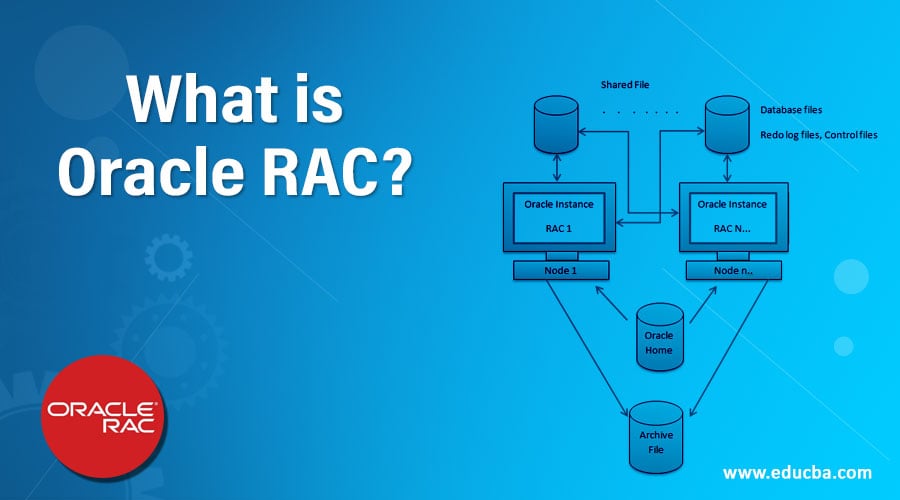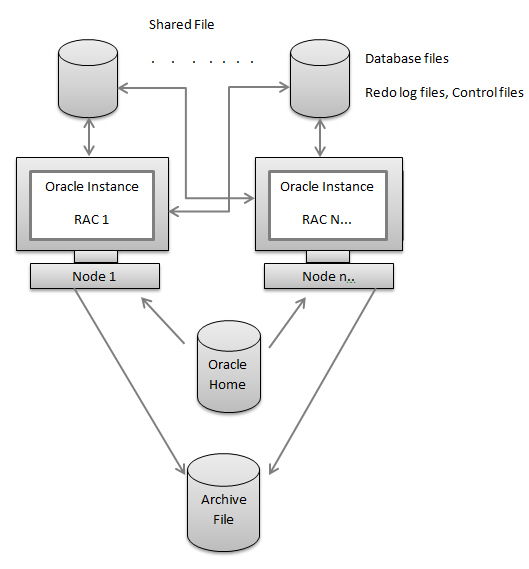Updated May 19, 2023

What is Oracle RAC?
Oracle Database with the Oracle Real Application Clusters (RAC) choice enables multiple instances operating on diverse servers to access a similar physical database stored with distributed Storage. The database covers various hardware devices. However, it shows up as a single specific database for the application. This permits the use of commodity hardware to minimize the total cost of the property and also to give a scalable computing environment the fact that it supports numerous application workloads.
Understanding Oracle RAC
As per the above diagram
- Oracle Database is a Storage device.
- Oracle Instance is a Memory and Process handler.
- Oracle Databases combines 3 different types of files: control files, redo log files, and database files.
- The cluster file system or shared raw devices allow all computers in the cluster to access and store the control files, online redo log files, and database files.
- You will find multiple Oracle instances, often one per node; all of these may access the database.
- Every Oracle instance contains a unique quantity and term, the Oracle system Identity. For the Oracle instance links towards the collection, the bond is usually described by ecosystem variable ORACLE_SID or perhaps be a connected thread.
- Every Oracle instance creates a unique set of online redo logs, often mirrored online redo logs based on the settings. Internets redo threads, recognized by their unique amount, constitute all of the categories owned by an individual instance.
- Every Oracle instance creates a unique offline redo log, recognized by thread and continuous series amounts. The offline redo logs become regular data files within a distributed file system. You may get all these data files around the globe, that is certain, with every node working an instance.
Clients can add nodes if they require extra processing capacity instead of changing their accessible servers. The only requirement is that servers in the cluster need to work with a similar operating system and the same version of Oracle. They cannot need to be of identical capability.
High Availability
They cannot manage any downtime within their conditions. These desires incorporate critical components such as preferred servers, networks, customer connections, etc., which are not just separated from databases. We require an intelligent resource supervisor that can redirect incoming workloads effectively to nodes that can be nonproductive or sometimes more competent in relating to computing power and Storage.
The Oracle RAC Category of Solutions offers a fine-tuned item package to ensure all these wants will be fulfilled. The following components usually compose the collection known as the “Oracle RAC Category of Alternatives.”
Advantages
- It might help you save some money.
- It can be load balanced to get higher efficiency.
- DML procedures can easily roll back.
- Visibility can be managed through the software.
- You can find transport among top quality services which usually helps easy and quick consolidation in a data center.
- Except if the connections are certainly not RAC conscious, you don’t need to get a reconnection.
Required Skills
The required skills are explained below.
1. Virtualization
Reach grips with the simple virtualization by using VirtualBox. If you are working with Linux, you will understand to be more knowledgeable about fundamental Linux system administration before moving forward. The combination of virtualization and Linux system administration will significantly assist when installing RAC and figuring out problems.
2. Automatic Storage Manager (ASM)
ASM is required to get RAC on Standard Edition (SE). For Enterprise Edition (EE) you may use other distributed Storage designs, as it does not require ASM. However, you will probably need ASM, which has RAC with EE. Single-instance systems could teach essential ASM skills.
Don’t expect one successful setup means you need to go on. Make an effort to set up different types of RAC on different operating-system types. You can strike complications; don’t expect one successful setup means you need to go on. Make an effort to set up different types of RAC on different operating-system types. You can strike complications; however, handle this kind of learning idea.
Why Should we Use Oracle RAC?
- It is a shared-everything cluster with one stage of failing and bottleneck: the storage subsystem. That shared-everything subsystem made sure that OLTP workloads will be highly steady regardless if there are numerous Oracle RAC nodes.
- Therefore, if you boost the quantity of RAC nodes, I/O performance will not linearly boost because of the singleton storage subsystem. Specifically, boost as the quantity of RAC nodes raises can be Processor and memory.
- RAC benefits Cache Fusion (a quickly dedicated backplane the nodes use to connect) that allows the cluster users to share data that may be cached inside the SGA. This means the entire SGA with the whole cluster (and therefore the quantity of data that can be cached) is nearly the sum of the SGA’s nodes.
- In general: RAC scales state (due to scale-out among Processor and memory); however, it cannot scale creates (due to singleton storage subsystem).
- Until you utilize Exadata.., the storage subsystem may scale away (every storage cell possesses its Processor, RAM, flash, and hard disks).
Who is the Right Audience for Learning Oracle RAC Technologies?
Oracle is usually similar to SQL Server and each additional relational database system. All computers in the cluster can access the cluster file system or shared raw devices, where the control files, online redo log files, and database files are stored. The database architectural concepts are identical, and they work with SQL (Structured Query Language) and Oracle’s PL/SQL extensions. It is easy to understand — if you have a great deal with Linux and SQL.
- Linux Administrators
- DevOps Engineers
- Oracle Database Administrators
- IT Professionals
How will this Technology help you in Career Growth?
Qualified Oracle Database Administrators (DBA) are usually in demand on the market. Likewise, being a company’s database keeps growing; we have a large requirement for people who can manage, maintain as well as, and develop databases since arranging up/designs, troubleshooting challenges, and setting guidelines to increase efficiency.
One of the most important qualifications is a considerable database administration background and an experience in Oracle systems. Oracle also provides three amounts of qualification for database administrators, which usually also contains Oracle Certified Associate, Oracle Certified Professional (OCP), and Oracle Certified Master (OCM), which can likewise boost job leads.
Conclusion
Identifying services to get a provided configuration requires looking at the following:
- Support to get that Oracle Database
- That Oracle RAC Technology Compatibility Matrixes (RTCM)
- Oracle Documents relating to additional requirements
- Alternative cluster solutions and other cluster file units as required
Support to get Oracle RAC can be “layered” and will not reflect on hardware to some extent
- Whenever every layer is reinforced, a method recognizes Oracle RAC.
- Case: Within a provided procedure, when the Oracle Database can be recognized, although it usually does not fulfill network or storage space wants to get Oracle RAC, it cannot be identified for Oracle RAC.
- In these ways, a method that may be recognized for Oracle RAC is usually always helpful for that Oracle DB.
Recommended Articles
This has been a guide to What is Oracle RAC? Here we discussed the basic concept, working, career growth, skills, and advantages of Oracle RAC. You can also go through our other suggested articles to learn more –

